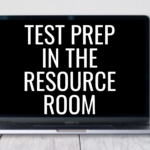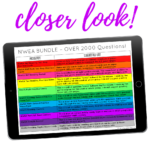

Table of Contents
ToggleTest preparation is non-negotiable in many classrooms and the resource room setting is no exception. Often it can feel like “testing season” takes over in the spring and learning comes to a screeching halt through the end of the school year.
Intentional organization and planning can help conquer this so that test prep and learning can continue in all special education settings.
Let's get organized with test preparation resources!
The first step is to move past filling in those multiple choice bubbles with a multi-sensory approach. The following resources were created to prepare for the NWEA (Northwest Evaluation Association) MAP assessment for Primary Math and Primary Reading (grades K-1 subject area):
Each resource is organized to include practice questions in the following formats:
Task Cards – ideal for “in person” learning, print the cards to add to small groups as warm-ups or quick checks for understanding.
Slides – display these full-color slides for small or whole groups, both in person or online. These slides are interactive because they include both question AND answer slides – as a student answers each question, they can click through to check their work (independence!).
Centers – hands-on learning games (small groups) and centers (independent or with partners).
These questions are organized by the RIT scale provided from the map tests..
Guided Practice Slides – digital option, these slides walk through the FIVE problem-solving steps (read more about them here). These test prep questions focus on specific skills are also self-checking.
Now that the resources are organized, how are we going to fit test prep into everyday learning in the resource room?
All the resources are labeled by RIT score range (Rasch Unit) – this indicates the students' current instructional level. It's possible that you may have students spanning 6-7 RIT band ranges at any time during the school year!
Although national norms are indicated within the testing system, our main focus is helping students grow to the next level – these resources can make it so much easier to plan activities that support this goal.
Planning and Differentiation
Using the Primary Reading assessment test results as an example, I may organize instruction for three different groups:
Notice that Group 2 has the smallest range – 151-170. This level is the NWEA grade level norm for first graders during the school year. Many students may not yet be able to work at that instructional level, so they would be working in a more focused Group 1. It's important to also have a map growth test plan for students working above RIT band range 170 so they can continue to show progress. The score reports from the previous map assessments can help guide this planning.
Next Steps for Planning
Now that the resources are organized and the groups are determined by leveled questions, it's time to put this plan into action!
“Testing season” gets a well-deserved bad reputation because it seems to overtake other learning (and common sense, if we're being completely honest). To conquer this, plan to fold these practice questions into every day learning:
3-5 questions as a warm-up during small or whole groups
Small Group Activities
Independent Centers
Planning for practice everyday (vs. huge “cram sessions”) is the key to success in preparing for the map assessments. With early learners in kindergarten and first grade, we aren't even talking about high-stakes test. Instead we are focused on applying our problem-solving skills to “show what we know.”

I cannot wrap up this article without mentioning the elephant in the room – as an educator working with young children, I didn't support school districts decisions to use formal testing to measure child's academic ability. From observation during test administration, it was difficult to watch children choosing an answer based on their favorite color (that happens!) or a students answers several questions incorrectly based on not fully understanding the language usage.
In summary, it didn't seem that the testing systems we used provided a great option for accurately measuring an individual student's learning level. It felt much better to incorporate academic skills outlined in the map growth assessments into our everyday classroom instruction. Students then were able to become familiar with the types of test items (language) in a more developmentally appropriate setting.
These organization and planning tips can apply to any assessment or standardized test focused on student performance. These organization and planning tips can apply to any assessment or standardized test focused on student performance.
Ready to skip the practice tests and focus on each child's progress?
For a closer look at these interactive NWEA MAP testing practice resources, check them out here:


I’m Jennifer and I was a special educator in the elementary school setting over the past decade. I entered the classroom every day dedicated to making learning inclusive AND engaging.

















This website uses cookies to ensure you get the best experience on our website. See full disclosure here.
This website uses cookies to ensure you get the best experience on our website.
See full disclosure here.